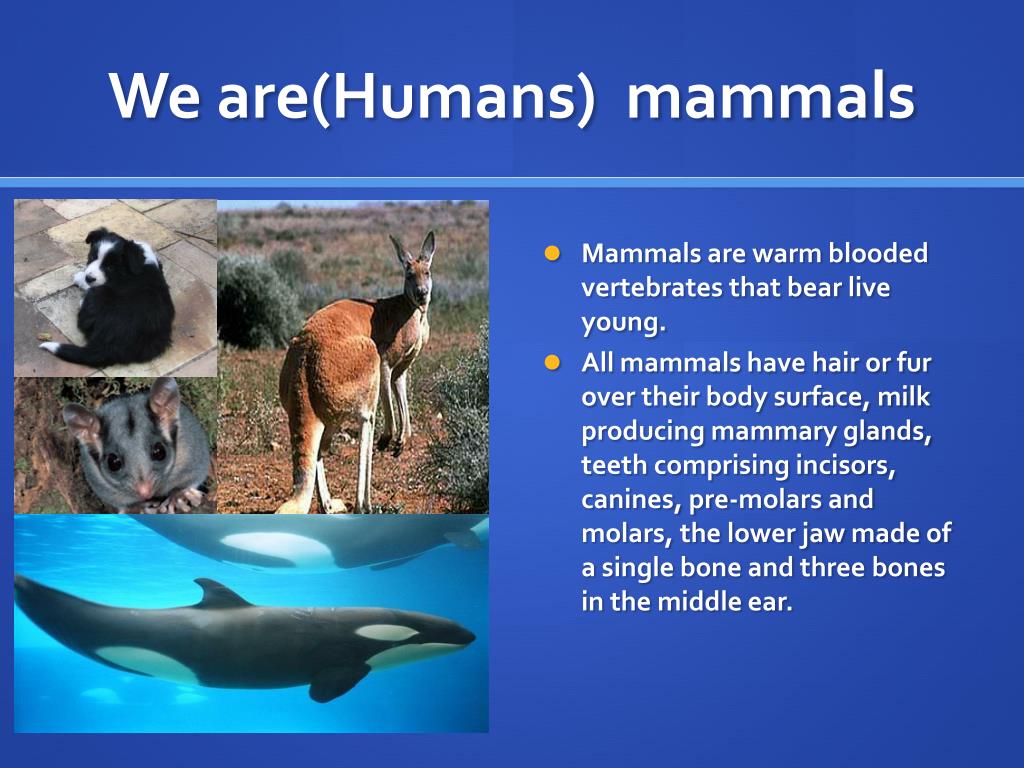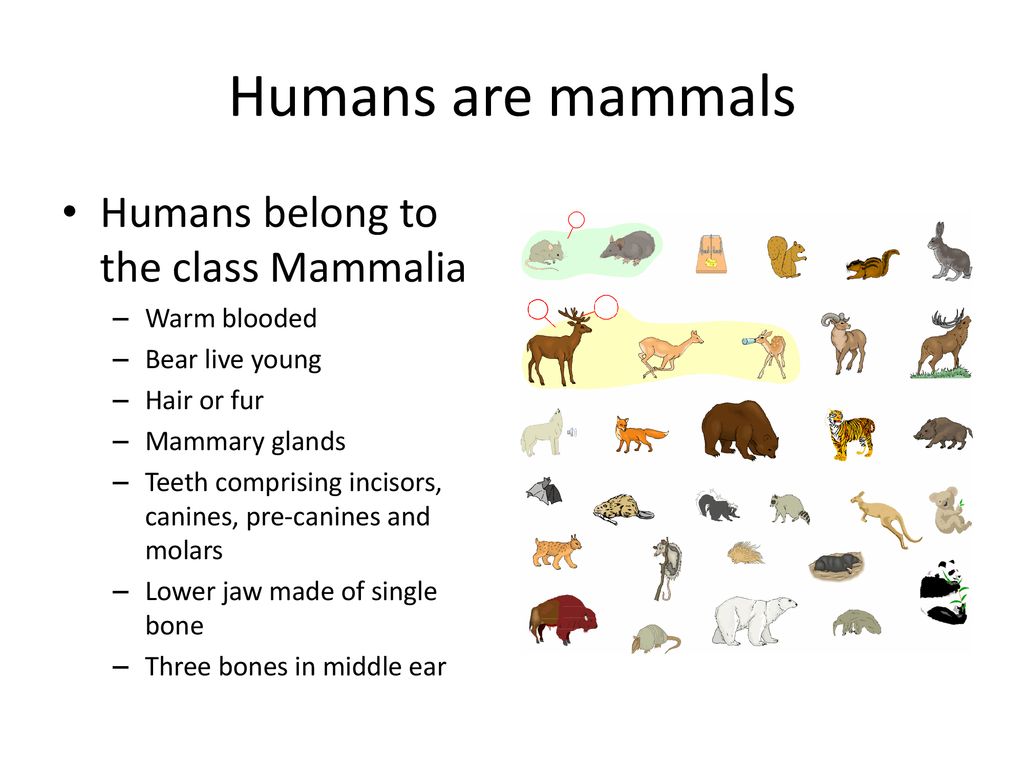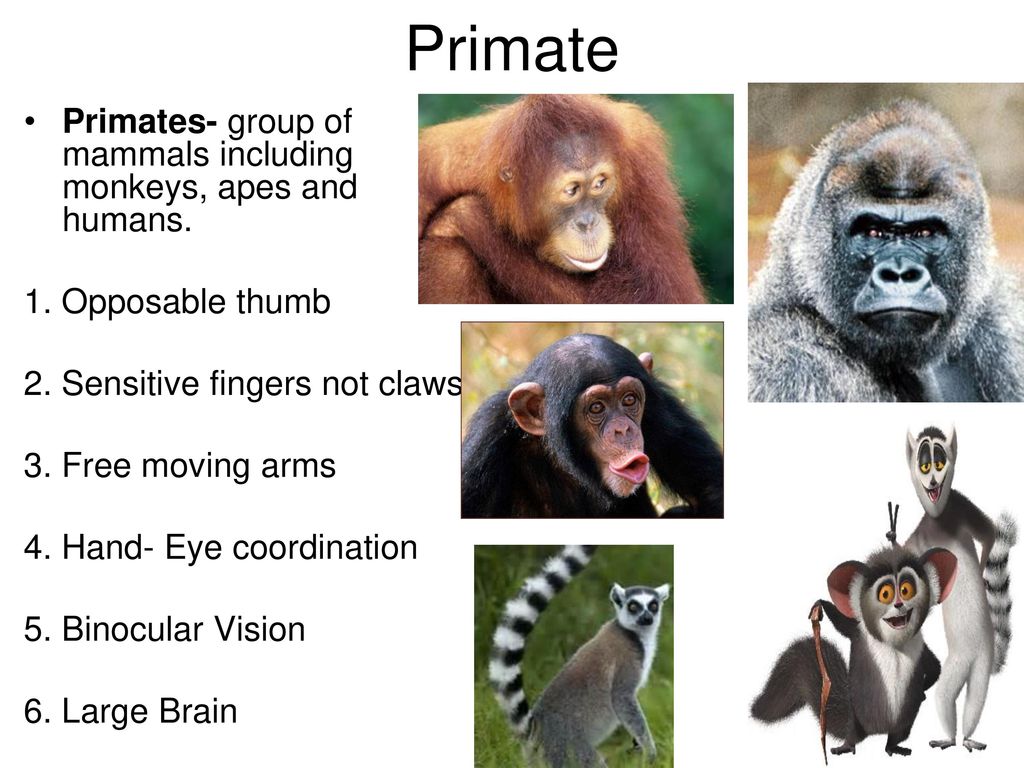Are Humans Mammals - A Closer Look At Our Animal Family
It’s a question many of us might ponder from time to time, maybe while watching a nature program or just thinking about where we fit in the grand scheme of living things. The simple answer, the one that clears things up right away, is yes, we are indeed mammals. This isn't just a random label; it’s a classification based on some very specific things our bodies do and how we live our lives, just like so many other creatures sharing this planet with us.
When you really think about it, there are so many common threads that connect us to the broader animal kingdom. We eat, we sleep, we think, and we even communicate, which, you know, are all things that other animals do as well. These shared activities are just the tip of the iceberg, showing how much we are a part of the vibrant tapestry of life on Earth, rather than something entirely separate or standing alone.
So, perhaps you’re curious about what truly makes us part of the mammal family, what sets us alongside creatures from tiny mice to enormous whales. We are about to explore some of the fascinating traits that place us firmly within this group, looking at the characteristics that define what it means to be a mammal and how those very traits show up in us, too it's almost like discovering family secrets.
Table of Contents
- What Makes Us Mammals?
- Are Humans Mammals Because of How We Keep Warm?
- The Way We Bring New Life – Are Humans Mammals in This Regard?
- Nurturing Our Young – How Are Humans Mammals?
- More Than Just Mammals - Are Humans Animals?
- Our Unique Features – Are Humans Mammals Because of Our Hair?
- Do Humans Have Better Color Vision Than Other Mammals?
- Our Place in the Bigger Picture - Are Humans Mammals and Primates?
What Makes Us Mammals?
When we talk about what puts a creature into the mammal group, we are really looking at a set of very specific features that distinguish them from other types of animals. It's like a checklist, you know, a sort of club membership requirement that helps scientists sort out the living world. Humans, as it happens, tick all these boxes, which means we fit right in with the rest of the mammal crowd. These distinguishing marks are not just random quirks; they represent fundamental ways our bodies work and how we raise our young, setting us apart from, say, birds or reptiles. Basically, these are the big giveaways that show us our place in the grand scheme of life.
Are Humans Mammals Because of How We Keep Warm?
One of the most noticeable things about being a mammal, and something that definitely applies to us, is the way our bodies keep a steady warmth inside, no matter what the weather is like outside. We are what you might call "warm-blooded," which means our internal temperature stays pretty much the same, whether it's scorching hot or freezing cold. This ability to maintain a consistent body heat is something that truly sets mammals apart from many other animal groups, like lizards or snakes, whose body temperatures often go up and down with their surroundings. This internal thermostat allows us to be active in a wide range of climates, which is a rather handy trick to have, you know, for survival.
This process of keeping our bodies at a comfortable heat, even when the outside world changes its mind about the temperature, has a special name: thermoregulation. It’s a biological routine that our bodies perform all the time, without us even having to think about it. Birds also share this clever ability to keep themselves warm, which shows that while it's a key mammalian trait, it's not exclusive to them. But for us, as humans, this internal heating system is a very core part of our makeup, allowing us to move around, work, and simply live comfortably in all sorts of environments, pretty much everywhere on the globe.
The Way We Bring New Life – Are Humans Mammals in This Regard?
Another really important characteristic that places us firmly in the mammal category is how we welcome new life into the world. Unlike many creatures that lay eggs, like birds or fish, humans give birth to live young. This means that our babies grow and develop inside the mother’s body for a period of time, rather than in an egg laid outside. This method of reproduction is a defining feature for most mammals, offering a certain kind of protection and early nourishment for the developing offspring. It’s a significant difference from, say, a chicken hatching from an egg, and it really shows how are humans mammals in their fundamental life processes.
This whole process, from conception to birth, is a testament to the intricate workings of mammalian biology. It means that the little ones are born more developed and, in many cases, are ready to begin their journey outside the womb with a head start. While some other animal groups also give birth to live young, the combination of this trait with other mammalian characteristics is what truly makes the distinction. It’s a pretty amazing system, when you stop to think about it, allowing for a close connection between parent and offspring from the very beginning, something that is quite special, actually.
Nurturing Our Young – How Are Humans Mammals?
Perhaps one of the most endearing and universally recognized traits of mammals, including us, is the way mothers provide nourishment for their newborns. Female mammals produce milk to feed and sustain their little ones during their earliest stages of life. This liquid food is rich in everything a growing baby needs, offering both sustenance and a way to pass on important protections from the mother’s body. This act of nursing is a hallmark of the mammalian class, so it's a very clear indicator of how are humans mammals.
This production of milk is not just about feeding; it’s also a powerful bond-forming activity, creating a deep connection between the mother and her baby. It’s a biological provision that ensures the young get the best possible start, providing all the necessary elements for their initial growth and development outside the womb. This shared characteristic, the ability of mothers to create this nourishing liquid, is a truly special part of what makes us, and so many other creatures, members of the mammal family, something you can see just about everywhere in the animal kingdom, in a way.
More Than Just Mammals - Are Humans Animals?
Beyond being classified as mammals, it’s important to remember that humans are, at our core, animals. This might seem obvious, but sometimes we tend to think of ourselves as entirely separate from the rest of the living world. Yet, when you look closely, the similarities between us and other animals are quite striking and really quite fundamental. We all share basic biological needs and behaviors that connect us across species lines. For instance, just like a deer in a field or a fish in the ocean, we need to eat to get energy, we need to sleep to rest our bodies and minds, and we certainly think and communicate in our own unique ways. These are not just casual resemblances; they are deeply ingrained parts of what it means to be a living creature, and they show how very much we are part of the animal world.
There are countless shared characteristics that link us to the vast diversity of life around us. From the way our bodies are put together, featuring a backbone that places us among the vertebrates, to the basic urges that drive our daily existence, we share so much with our animal relatives. The way we interact with our surroundings, the way we learn, and even the way we express ourselves, all have echoes in the animal kingdom. It’s a reminder that while we might build cities and create complex societies, our fundamental biological programming ties us directly back to the natural world, pretty much like every other living thing.
Our Unique Features – Are Humans Mammals Because of Our Hair?
When you think about what makes a mammal, one of the first things that often comes to mind is hair or fur. And guess what? Humans have hair! While we might not be as furry as a bear or a cat, the presence of hair on our bodies is a feature that is unique to the mammalian class. This isn't just about the hair on our heads; it’s about the fine, often less noticeable hair that covers much of our skin. This characteristic, though sometimes less prominent in humans compared to other mammals, is a clear biological marker that confirms our place in this group. It's a bit like a secret handshake that only mammals share, showing how are humans mammals down to our very skin.
The hair on our bodies, even if it’s just a fine covering, serves a purpose, from helping with temperature regulation to providing a bit of sensory input. It's a reminder of our evolutionary journey and our deep connection to other hairy creatures. This shared trait, the presence of hair, really highlights the common ancestry we have with all other mammals, making it a very clear indicator of our biological classification. So, next time you notice a strand of hair, you can think of it as a little badge of honor, a sign that you are indeed a part of the amazing mammal family, something that is quite cool, actually.
Do Humans Have Better Color Vision Than Other Mammals?
When it comes to how we perceive the world around us, particularly in terms of color, humans do have some rather interesting differences compared to many other animals, including some fellow mammals. It’s true that we often see a wider array of colors than certain creatures, like our pet dogs and cats. Their view of the world is often made up of fewer and weaker colors, which means they might not experience the same vibrant spectrum that we do. For them, a bright red toy might appear as a duller shade, perhaps more like a muted yellow or blue. This difference in color perception is tied to the specific light-sensing cells in our eyes, and it's a fascinating aspect of how different species interact with their surroundings.
However, it's worth noting that "better" is a relative term here. While we might see more colors, some animals possess other visual abilities that surpass ours, such as seeing in the dark or detecting movement from a great distance. Our ability to discern a broad range of hues is just one of the many ways our senses have adapted to our particular way of living. It's a unique aspect of human biology, but it doesn't change the fundamental fact of how are humans mammals. It simply shows that within the large group of mammals, there’s a lot of variation in how each species experiences the world through its senses, which is really quite amazing.
Our Place in the Bigger Picture - Are Humans Mammals and Primates?
Beyond being mammals, humans also fit into an even more specific biological group: we are primates. This group includes a fascinating array of animals like monkeys and apes, and it's where we find our closest living relatives in the animal kingdom. Our scientific name, Homo sapiens, points to our identity as the only surviving species within a smaller family known as hominids. This hominid group once included creatures like chimpanzees, gorillas, and orangutans, showing a very close evolutionary connection. So, when we ask are humans mammals, the answer is yes, and then some; we are also part of this very special primate lineage, a rather unique branch on the tree of life.
The fact that we are primates means we share a common ancestor with these other intelligent and often social creatures. It means that many of our physical features, from the structure of our hands to the way our brains are organized, have echoes in the primate world. For instance, while a human arm, a bird's wing, and a bat's wing might look quite different on the outside—one covered in skin, another in feathers, and the last in hair—their internal bone structures often show surprising similarities, pointing to a shared ancestry. This tells a story of adaptation and change over vast periods of time, but the underlying blueprint often remains, which is pretty cool to consider.
It's also interesting to consider the vast stretches of time involved in this grand biological story. Humans, as a species, are believed to have made their appearance on Earth around 300,000 years ago, which might sound like a very long time. However, mammals as a whole have been present for a much, much longer stretch—about 200 million years. This puts our own species' existence into a broader perspective, showing us as relatively newcomers on a planet that has hosted mammalian life for an incredibly long time. It highlights the deep roots of our mammalian identity, showing just how long these fundamental characteristics have been around, shaping life as we know it, really.
Another point of variation within the animal kingdom, including among mammals, is the number of chromosomes each species carries. Humans, for example, have 46 chromosomes in most of our cells. But this number can vary quite a bit among different animals. A pig, for instance, has 38 chromosomes, while a horse has 64. These differences in chromosome count are part of what makes each species distinct, contributing to their unique traits and how they pass on genetic information. So, while we share many fundamental characteristics with other mammals, these tiny genetic details remind us of the incredible diversity that exists within the larger animal family, something that is truly amazing to think about.
So, when you consider all these points – our warm blood, the way we give birth to live young, how mothers provide milk, the hair on our bodies, and our place within the primate family – it becomes very clear that humans are indeed mammals. We share a deep connection with countless other creatures on this planet, bound by common biological processes and a shared evolutionary past. These fundamental traits are what define our place in the natural world, showing that we are very much a part of the vibrant animal kingdom.
- Claressa Shields Movie
- Amy Poehler Movies And Tv Shows
- Jaden Mcdaniels
- Bobbi Althoff Feet
- Rachel Jacob Savage

PPT - Human Evolution PowerPoint Presentation, free download - ID:2109595

EL: To summarise the evolution of humans - ppt download

Genus & Species- Homo sapiens - ppt download